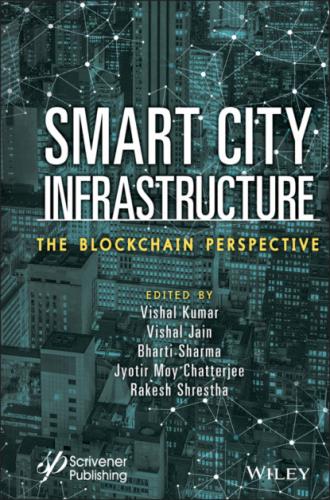Smart City Infrastructure. Группа авторов
9 Index
List of Illustrations
1 Chapter 2Figure 2.1 Smart city according to Nokia.Figure 2.2 Elements of a smart city.Figure 2.3 IoE.
2 Chapter 3Figure 3.1 Smart city—Conceptual framework.Figure 3.2 Trend in development of smart cities.Figure 3.3 Integration of technologies in smart cities.Figure 3.4 Basic working of blockchain technology.Figure 3.5 Categorization of artificial intelligence.Figure 3.6 Smart city model using blockchain technology.Figure 3.7 Applications in smart city using blockchain technology.Figure 3.8 Framework of security in smart cities.Figure 3.9 Role of AI in developing smart city.Figure 3.10 Infrastructure of four-layer smart city.Figure 3.11 Operation of autonomous vehicles using AI and LiDAR technology.Figure 3.12 Smart surveillance by night vision thermal camera system.Figure 3.13 Smart energy management system with NILM algorithm.
3 Chapter 4Figure 4.1 Population in few larger cities of India [6].Figure 4.2 Information and communication technology (ICT) [15].Figure 4.3 Air pollution in world [7].Figure 4.4 Death caused by flood [10].Figure 4.5 World road traffic [11].Figure 4.6 Rural population in India [6].Figure 4.7 Illustration image of smart meter reading [2].
4 Chapter 5Figure 5.1 Use case of manufacturer.Figure 5.2 Use case of dealer.Figure 5.3 Use case of registration authority.Figure 5.4 Use case of police.Figure 5.5 Use case of customer.Figure 5.6 Sequence diagram.Figure 5.7 High level view of architecture.Figure 5.8 Detailed view of architecture.Figure 5.9 Level 0 DFD.Figure 5.10 Level 1 DFD.Figure 5.11 Level 2 DFD.Figure 5.12 Activity diagram.Figure 5.13 Entity relationship diagram.Figure 5.14 Schema for assets.Figure 5.15 Schema for manufacturer.Figure 5.16 Schema for RTO.Figure 5.17 Schema for dealer.Figure 5.18 Schema for police.Figure 5.19 Schema for customer.Figure 5.20 Front page.Figure 5.21 Main page.Figure 5.22 Asset creation.Figure 5.23 Model testing for manufacturer.Figure 5.24 Transaction history.Figure 5.25 Process history.Figure 5.26 Docker file.Figure 5.27 Test cases.
5 Chapter 6Figure 6.1 Parameters that are controlled by the fuzzy controller.Figure 6.2 Input/output block in fuzzy logic control for adaptive chair and desk...Figure 6.3 Block diagram of the fuzzy logic controller.Figure 6.4 Membership function for the height of the person.Figure 6.5 Membership function for the chair’s height.Figure 6.6 Membership function for the armrest height.Figure 6.7 Membership function for the desk height.Figure 6.8 Membership function for the eye height level.Figure 6.9 Surface view of eye height level.Figure 6.10 Surface view of chair’s height.Figure 6.11 Surface view of desk height.Figure 6.12 Surface view of seat depth.Figure 6.13 Rule view of the complete adaptive system, showing results for the p...
6 Chapter 7Figure 7.1 Traditional pattern of commodity flow from domestic to international ...Figure 7.2 Generation of letter of credit from banks to firms. Source: Author’s ...Figure 7.3 International trading of commodity through blockchain technology. Sou...Figure 7.4 Presentation of cost associated with FOB in soybeans export supply ch...Figure 7.5 Representation of cost of handling in a triangular distribution throu...Figure 7.6 Handling stage from point of origin through @Risk in Pert distributio...Figure 7.7 Supply chain process for exporting soy beans with PERT identification...
7 Chapter 8Figure 8.1 Blockchain in smart farming.Figure 8.2 Proposed IPFS blockchain-based smart agriculture management system.Figure 8.3 Architecture of agricultural product information system.Figure 8.4 Data management model.Figure 8.5 Android application interface for farmers.Figure 8.6 ThingSpeak and MATLAB output of various data fields from the smart fa...
8 Chapter 9Figure 9.1 Characteristics of blockchain technology.Figure 9.2 Types of blockchain.Figure 9.3 DPoS.Figure 9.4 Benefits of PBFT.
9 Chapter 10Figure 10.1 Different dimension smart city.
10 Chapter 12Figure 12.1 A block of blockchain.Figure 12.2 Chain of blocks.Figure 12.3 Chain of blocks with invalid reference.Figure 12.4 Block structure.Figure 12.5 Hashing and digital signature.Figure 12.6 Byzantine general problem.
11 Chapter 13Figure 13.1 Conventional developed city [3].Figure 13.2 The proposed future smart city adapted from [11].
List of Tables
1 Chapter 2Table 2.1 Extract of concepts often associated with the “smart city”.Table 2.2 Smart city domains and sub-domains.Table 2.3 Summary of technology and data.Table 2.4 Economic overview.Table 2.5 Population domain summary.Table 2.6 Some definitions of the IoT.Table 2.7 Some scenarios for the IoT.Table 2.8 Summary of the impact of the scale on the IoT.Table 2.9 Summary of the impact of heterogeneity on the IoT.Table 2.10 Summary of the impact of the physical world on the IoT.Table 2.11 Security and privacy issues in the IoT.Table 2.12 Some regions already equipped with intelligent security.Table 2.13 Concrete use cases of “smart water” technologies.
2 Chapter 5Table 5.1 Comparative analysis.
3 Chapter 6Table 6.1 Average screen time spent by different age groups and gender.Table 6.2 Data of different parameters with respect to height of the person.Table 6.3 Algorithm of fuzzy logic controller.Table 6.4 Membership function for the height of the person.Table 6.5 Membership function for the chair height.Table 6.6 Membership function for the armrest height.Table 6.7 Membership function for the desk height.Table 6.8 Membership function for the eye height level.Table 6.9 Rule base for the adaptive chair and desk system.
4 Chapter 7Table 7.1 Structure of contract payment.Table 7.2 Distribution of cost and various sources of assumptions.Table 7.3 Costs and time elapsed by Monte Carlo simulation.
5 Chapter 9Table 9.1 Comparison between different types of blockchain.
6 Chapter 10Table 10.1 Present state of art in different dimension of smart cities.
7 Chapter 11Table 11.1 Consensus algorithm alongside the conceptualization.Table 11.2 Transaction latency.
Pages
1 v
2 ii
3 iii
4 iv
5 xvii
6 xviii
7 xix
8
